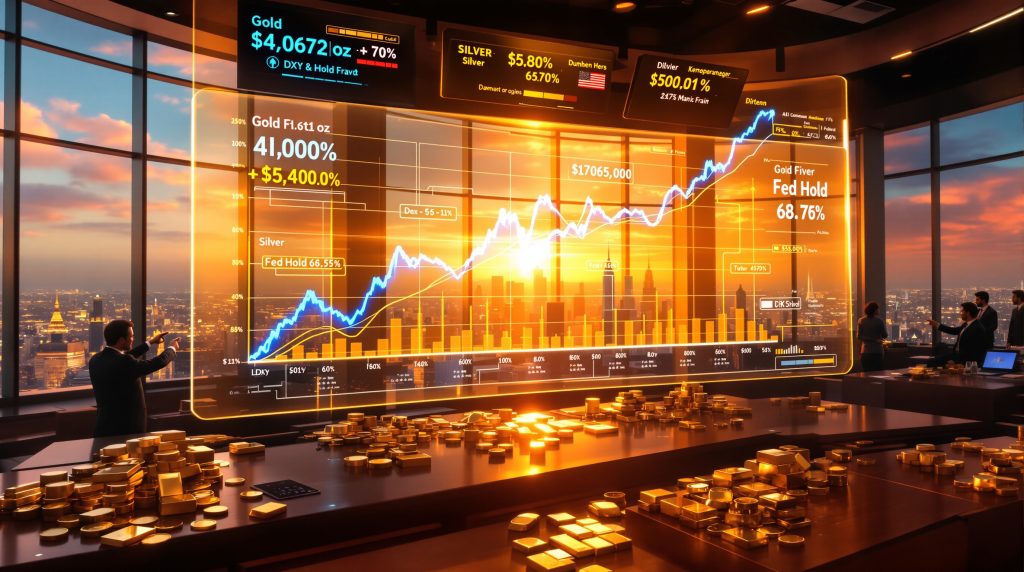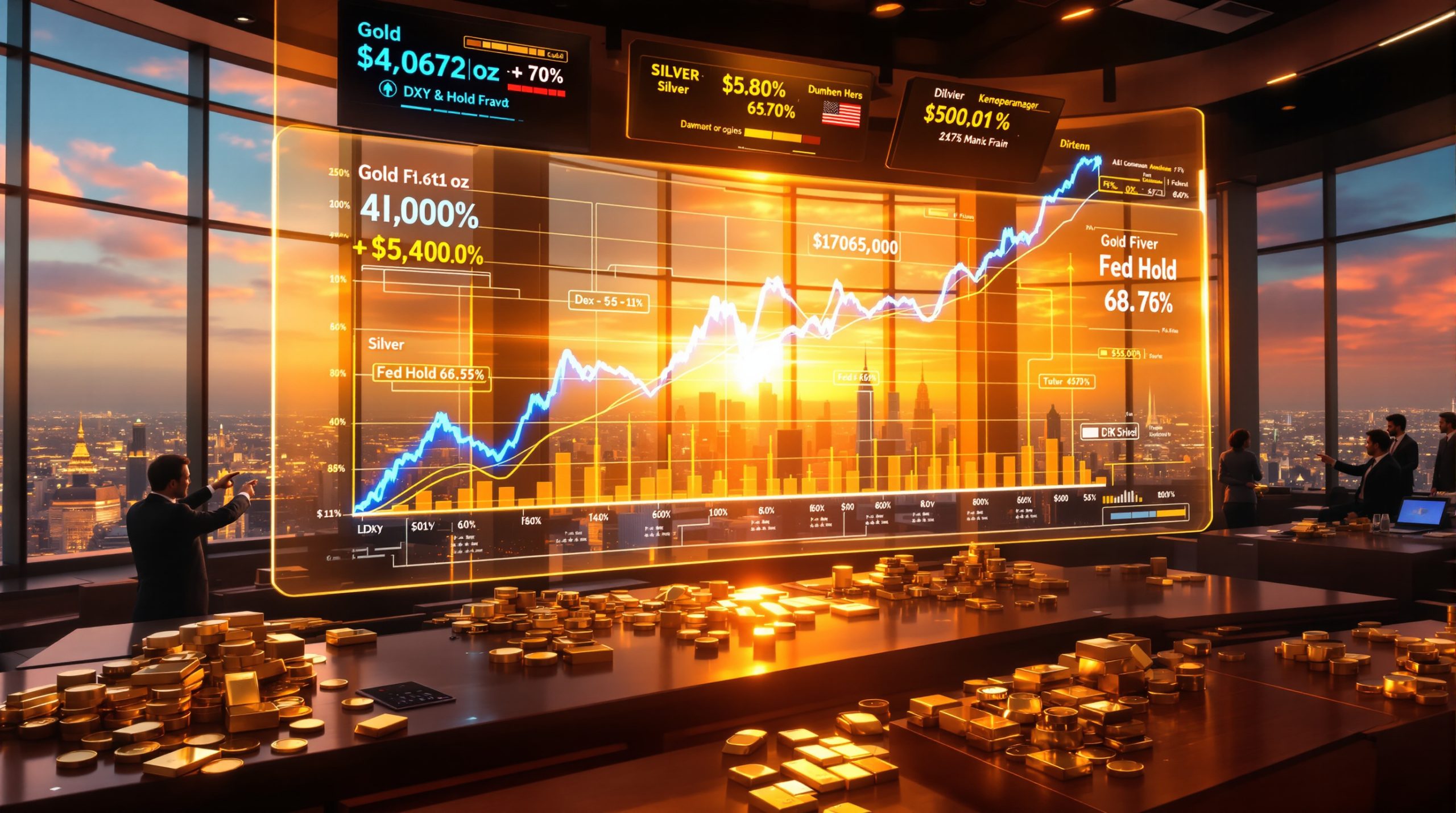The shifting dynamics of the global economy in late 2025 are defined by complex interactions between rapid technological advances and persistent demand for traditional stores of value. The interplay between the so-called AI bubble and gold price consolidation offers a unique vantage point into both risk appetite and defensive positioning across global portfolios. Furthermore, understanding these market forces requires examining how different asset classes respond to evolving economic conditions.
Intersecting Economic Environments: Market Volatility Under the Microscope
Understanding how technology-led equity cycles differ from commodity-based flows is essential in this environment. While AI sector enthusiasm, epitomised by marquee tech stocks, continues to propel market benchmarks like the NASDAQ, gold and silver operate within fundamentally different capital flow paradigms shaped by safe-haven demand and monetary uncertainty.
Recent weeks have seen gold hovering in a consolidation pattern, fluctuating between $4,000 and $4,100 per ounce (USD), with sterling-based gold approaching £3,100 and euro-denominated prices at roughly €3,520. Silver, after reaching a historic high above $54 per ounce, has settled around $51. These commodity patterns contrast sharply with recent surges in technology indices, highlighting the divergent forces sculpting global asset allocation.
Meanwhile, headline macro indicators continue to add fuel to the volatility. The gold market outlook for the coming months remains highly dependent on these underlying economic pressures.
Additionally, the following developments have emerged:
- The US Dollar Index (DXY) surged by 1% in just five days, placing further downward pressure on gold and silver.
- Probability of the Federal Reserve holding rates steady in December climbed sharply from 44.1% to 68.2%, stirring expectations for "higher-for-longer" monetary conditions.
- Strong AI sector earnings, particularly from major players like Nvidia, have momentarily eased fears of a rapid tech sector downturn, buoying equities even as commodity markets tread water.
| Indicator | Value / Trend | Macro Impact |
|---|---|---|
| Gold Price (USD/oz) | $4,062 – $4,200 (consolid.) | Safe haven demand, resistance contacts |
| Gold Price (GBP/oz) | ~£3,100 (high end) | Policy risk, GBP weakness |
| Gold Price (EUR/oz) | ~€3,520 | Eurozone inflation dynamics |
| Silver Price (USD/oz) | $48 → $54 (peak), now $51 | Supply tightness, industrial demand |
| US Dollar Index (DXY) | +1% in 5 days | Amplifies commodity headwinds |
| CME FedWatch (Rate Hold) | 68.2% (up from 44.1%) | Signalling hawkish monetary sentiment |
Economic Headwinds and Tailwinds in Play
Inflation expectations, heightened geopolitical tension, and fiscal policy uncertainty have converged to sustain volatility across assets. Notably, repeated attempts by gold to breach $4,200 have met strong resistance, while the resilience of tech stocks reflects continued optimism for AI-driven growth.
This dual-track market environment demands careful navigation from investors seeking both growth and stability. For instance, concerns about US economy and inflation continue to influence monetary policy expectations and asset allocation decisions.
How "AI Bubble" Speculation Alters Financial Market Behaviour
Investor Psychology: Risk Cycles and Market Sentiment
Behavioural economics teaches that periods of rapid sector-specific growth—such as in AI—are often accompanied by narratives of euphoria and scepticism. 2025's landscape vividly illustrates this, as investors assess whether surging valuations in AI-heavy indices are underpinned by fundamentals or susceptible to classic bubble dynamics.
The effect is tangible: stronger-than-expected earnings from market leaders like Nvidia have sent stock indices sharply higher, temporarily assuaging fears of a collapse. According to recent analysis from Fortune, bond market experts are increasingly viewing gold as a hedge against potential AI market volatility.
Instead of an across-the-board market retreat, capital rotates selectively, with some risk-averse investors seeking refuge in safe-haven assets like gold and silver. Consequently, the silver market squeeze has created additional dynamics affecting precious metals pricing.
A recent swing in rate expectations offers a telling snapshot:
- Just one week ago: The market assigned a 55.9% probability to a rate cut in December.
- Today: The probability of no change stands at 68.2%, largely in response to robust tech sector earnings.
Markets are thus highly sensitive to these narratives, swiftly reweighting portfolios based on short-term signals.
Why AI Bubble Fears Matter for Gold?
When investors sense over-extension in growth sectors, they often rebalance into stores of value such as gold, triggering periods of price consolidation or rally in the precious metals space. However, this relationship isn't always straightforward, as global recession risks can complicate traditional flight-to-quality patterns.
Evidence of Capital Rotation
Not only do ETF flows and derivatives benchmarks like the VIX support this pattern, but investor positioning also reflects sectoral rotation in real time. When AI earnings deliver positive surprises, expectations for rate cuts wane, the dollar strengthens, and gold pauses or retreats. When fears resurface, the reverse occurs.
Structural Drivers Behind Gold's Consolidation
Physical Market Signals and Institutional Demand
Precious metal consolidation is not simply a byproduct of speculative flows; underlying fundamentals remain robust, particularly for silver. The relationship between gold bond dynamics has also become increasingly important in understanding current price movements.
Physical market indicators include:
- Vault withdrawals: The Shanghai Futures Exchange has reported notable drains in physical silver inventories, a strong sign of persistent demand from Asia.
- Backwardation: Spot silver regularly trading at a premium to futures contracts suggests that immediate demand continues to outpace available supply—a fundamental bullish signal that often precedes price support or future breakouts.
- Central bank activity: With policy uncertainty still prevalent and central banks split on the direction of US rates, institutional allocations across gold and silver remain cautious but persistent.
Summary of Major Resistance and Support Levels
| Metal | Support Level | Resistance Level | Current Zone |
|---|---|---|---|
| Gold (USD) | $4,000 | $4,200 | $4,000 – $4,100 |
| Gold (GBP) | £3,000 | £3,120 | £3,070 – £3,100 |
| Gold (EUR) | €3,500 | €3,550 | €3,510 – €3,520 |
| Silver (USD) | $50 | $54 | $51 – $52 |
Physical market signals, such as the persistent backwardation of silver and continued vault withdraws, differentiate the consolidation phase from earlier cycles characterised predominately by speculative trading.
Technical Factors Underpinning Stability
Technical analysis reveals several key patterns:
- Repeated attempts to push gold above $4,200/oz have met with resistance, while lower bounds at $4,000/oz remain supported by periodic safe-haven flows.
- The $54/oz level remains a major barrier for silver, with intermediate support developing around $51–$52/oz.
Precious metals are thus encountering simultaneous resistance from a strong US dollar and technical seller pressure, against a backdrop of solid physical demand.
The Role of Central Bank Policy and Currency Flows
The Feedback Loop Between Rates, Currencies, and Metals
Monetary policy speculation is acting as the primary steering mechanism for capital allocation across risk and defensive assets. With the Federal Open Market Committee divided and the CME FedWatch tool tilting sharply towards a December rate hold, the strength of the US dollar has amplified short-term pullbacks in the metals market.
"Currency volatility and shifting interest rate expectations are the central drivers governing international gold allocations. Extended periods of elevated rates typically restrain upside for non-yielding assets, but rapid shifts toward dovish policy—especially if triggered by labour market deterioration—can unlock explosive rallies in gold and silver."
Transmission Pathways
Furthermore, several key mechanisms influence precious metals pricing:
- Hawkish policy signals and dollar strength reinforce a ceiling on gold and silver.
- Any sudden evidence of labour market slack (such as in delayed non-farm payrolls data) or economic contraction could catalyse a sharp reversal in the metals.
Silver's Physical and Industrial Market Signals
Backwardation and Supply Chain Frictions
Persistent backwardation in silver futures, where spot prices remain above deferred contracts, signals ongoing physical tightness rather than a temporary market anomaly. This mirrors continued reports of silver withdrawals from the Shanghai Futures Exchange—pointing to robust demand for immediate delivery, especially from the Asian market.
Additionally, silver's industrial demand adds a unique macro dimension:
- The solar photovoltaic sector accounts for a significant share of annual silver consumption, with cutting-edge electronics and EVs increasing their footprint.
- Periodic shortages in physical or deliverable silver force market participants to pay a premium, a trend reflected in Asian spot market premiums and sustained inventory draws.
Backwardation in this context is more than just a technical curiosity—it is a harbinger of deeper supply-side imbalances that can influence future pricing. Moreover, insights from Julius Baer suggest that AI market developments continue to shape precious metals demand patterns.
Macro Risks and Forward-Looking Scenarios
Strategic Outcomes Table: Q4 2025 and Beyond
| Scenario | AI Asset Cycle | US Rates & Dollar | Gold/Silver Outcome | Key Factors |
|---|---|---|---|---|
| AI Bubble Bursts | Tech selloff, volatility | Fed pivots dovish | Surge in haven demand | Capital flight, rate cuts |
| Strong AI Earnings | Equities rally | Rates hold/slow hikes | Metals consolidate | Risk-on sentiment, stronger dollar |
| Hawkish Fed | Tech sector cools | Dollar strengthens | Downward price pressure | Persistent inflation |
| Labour Weakness | Value rotation | Anticipated rate cuts | Breakout for gold/silver | Payroll data, macro uncertainty |
The probabilities for each scenario hinge on a constellation of fast-evolving factors, ranging from tech sector surprises to central bank resolutions and geopolitical flashpoints. In addition, the AI bubble and gold price consolidation relationship will likely evolve as market conditions change.
Actionable Insights: What to Watch
Top macroeconomic data and signals to monitor include:
- Non-farm payrolls and unemployment data for early signs of labour market deterioration
- Sector ETF flows to track capital rotation between growth (e.g., technology/AI) and value (commodities, defensives)
- Central bank statements and meeting minutes for emerging policy consensus or division
- Volatility indices and options market activity as proxies for risk-on/risk-off sentiment
Frequently Asked Questions
Why doesn't gold always rally with AI market fear?
Gold may consolidate or pull back during periods of AI sector exuberance, as risk appetite crowds out defensive allocations, especially if the dollar strengthens or rates are poised to stay elevated. However, the AI bubble and gold price consolidation dynamic can shift rapidly based on changing market sentiment.
Can prolonged silver backwardation sustain higher prices?
While backwardation is a strong supply-demand indicator, persistent structural tightness is required to drive lasting price appreciation. If supply constraints ease, backwardation may diminish—and with it, upward price pressure.
What are the best signals for spotting consolidation breakouts?
Monitor for confirmed moves above key resistance levels (e.g., gold's $4,200/oz, silver's $54/oz), accompanied by increased volume and supportive macro headlines such as dovish policy pivots or unexpectedly weak economic data.
Navigating an Era of Synchronised Asset Volatility
The current phase of synchronised volatility between the AI bubble narrative and gold price consolidation demonstrates the necessity of deep macroeconomic insight. Success in this environment depends on a willingness to adapt portfolio strategy to new data rather than rigidly adhering to forecasts.
Consequently, the AI bubble and gold price consolidation relationship will continue to evolve as markets digest new information. In times of conflicting cycles, robust cross-market analysis provides the clarity needed for resilient investment decisions.
Disclaimer: This article is for informational purposes only and does not constitute financial advice. Readers are encouraged to conduct independent research and seek professional advice before making investment decisions. Precious metal prices and equity valuations can be volatile and are influenced by many unpredictable factors.
Are You Ready to Harness Market Volatility?
Discover how Discovery Alert’s proprietary Discovery IQ model can give you the edge in today’s dynamic market. Stay ahead with real-time alerts on significant ASX mineral discoveries, and explore how historical trends translate into exceptional returns on our Discoveries page.




